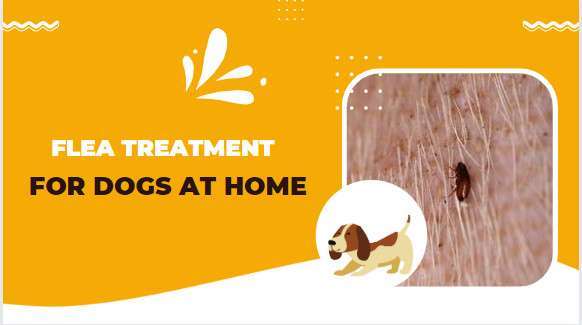Fleas are irritating. These tiny blood-sucking parasites irritate dogs and parasitize their homes. Often before you realize that fleas have invaded. Many dogs are allergic to flea bites, severe scratches, red and flaky skin, crusts, hot spots, and hair loss. Fleas can also cause tapeworms and anemia.
According to the research, fleas prefer animal hosts but rely on biting humans when animals are absent. They can feed on the host or infect the disease-causing bacteria by contaminating the stool when open wound scratches infected flea faces.
So further in this article, we have shared Flea Treatment For Dogs At Home
Fleas’ symptoms in the dog
- Excessive scratching and itching
- Skin Biting and chewing
- Irritating red skin
- patches
- Hair loss
- Flea dirt present
Identifying the flea life cycle
To effectively treat and eradicate these pests, it is best to understand all four flea life cycles.
Eggs: The egg cycle begins with very few flea eggs, whether indoors or in a warm, shaded, humid outdoor environment.
Larvae: Eggs hatch to become larvae, grow, and malt.
Chrysalis (cocoon): After melting, it forms a cocoon and turns into a pupa. There, it can wait several months before sensing the presence of heat, vibration, or carbon dioxide (such as those produced by dogs leaping, panting, or wagging their tails).
Adults: Adult fleas emerge to survive at the end of the bloodsucking day and are triggered to pounce and settle on potential hosts or jump from host to host.
In other words, the point is the flea dream retirement community. Its body is warm and attractive to chew. Hairy slits are excellent for spawning (every female lays hundreds of eggs in her lifetime). Also, without a host, adult fleas starve to death within 4 days.
Treatment and Prevention
Prevention is the best way to get rid of fleas on dogs. Flea and tick prevention kills fleas that come into contact with dogs and prevents puppies from bringing fleas home in the first place.
There are various options, from flea collars to topical liquid references and pills. Talk to your veterinarian about the safest and most appropriate flea prophylaxis for puppies and dogs.
If your dog already has fleas, this prophylaxis will continue to kill fleas, but you may need to take more aggressive actions like prescription prophylaxis.
You can also use fast-acting chemicals such as flea shampoo or flea tablets that kill dog fleas within hours. Again, it’s essential to seek advice from your canine veterinarian.
Eliminate Fleas in your space
Killing your dog’s fleas is only part of the problem. You should also decide how to get rid of fleas in your home. This requires patience. It may take up to 3-4 months to get rid of the infestation, as all fleas in your home take so long to pass their life stages.
Following these steps eliminate fleas.
- Clean all soft dog toys and dog beds in hot, soapy water. Do this frequently until the infestation is gone.
- It would help if you washed your bedding, threw rugs, bath mats, and blankets or cushions where your dog likes to sleep in hot water.
- Throw away the vacuum bag immediately in the outside garbage bin after vacuuming all carpets, hardwood floors, linoleum, tile, curtains, and upholstered furniture. For all the stages to be addressed, vacuuming should be done regularly.
- Hiring a pest control service if you cannot treat all flea stages yourself.
Flea Treatment In The Environment
Flea treatment requires all animals to be treated at home for complete success. You also need to consider the indoor and outdoor environments.
Flea Treatment For Dogs At Home
It is essential to wash all bedding with soapy water when dealing with indoor environments. Vacuum all carpets thoroughly and either discard the vacuum or empty the canister and remove the garbage bag. Steam cleaning the carpet can also kill some larvae.
However, be aware that vacuuming and shampooing your carpet will leave many live fleas and may require some chemical treatment.
The whole house is now ready for flea treatment. Several options are available, including a highly effective nebulizer. Boric acid-based products may be safer in homes with small children and in other situations where the chemical residue is significant.
The most effective products contain ingredients both for killing adult fleas and for killing other lifecycle stages.
Methoprene is one such growth regulator. In some cases, aerosol atomizers may not be penetrating enough to kill all hidden fleas and larvae.
Another option for indoor control is sodium borate products applied to carpets. You should consider calling a local disinfection company for a quote and ensuring their procedure removes fleas from your premises.
Fleas’ outdoors Control
Sprays and pelleted pesticides are commonly used for outdoor management after kennels and kennels have been thoroughly cleaned. Again, insect growth regulators are a good choice.
Pyriproxyfen is more stable in the sun and will last longer outdoors than Methoprene.
Diatomaceous earth, a non-toxic option, is highly effective and can be used safely in vegetable fields and children’s outdoor playsets.
When choosing a diatomaceous earth product, look for food-grade products such as diatomaceous earth food-grade powder that can be used safely around pets.
Some non-toxic nematodes (small insects) can also spread to areas of the garden that are warm and humid and often populated by pets and fleas.
Nematodes feed on flea larvae. And once snow builds upon the ground, most of the primary sources of fleas go away.
Final words
Tackling a flea epidemic may seem daunting, but you have many tools at your disposal.
If you act quickly, you can kill fleas on contact and disrupt their breeding cycle.
This includes vacuuming, high-heat washing, keeping the yard clean, and treating pets with topical anti-flea ointments.
The most important thing to remember is that you should treat your home, garden, and dog simultaneously. The combined approach is excellent for eradicating fleas and preventing future infestations.


